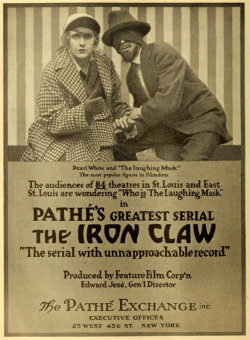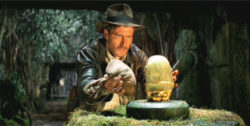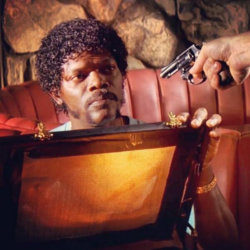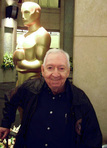MacGuffins
Since the MacGuffin was popularized by Alfred Hitchcock in the early 1930s, much has been written about the use of this term in the cinema world. All sorts of dissecting of this tool as a film-writing component has been made by just about everybody. I am sure there must be workshops where people are paying big bucks to learn all about MacGuffin and in the process talk it to death. A MacGuffin, you see, has an air of the elusive about it but all in all is not that complex.
 The idea of a MacGuffin was first coined by silent star Pearl White in1914 when she invented a movie serial called “The Perils of Pauline.” Each film was about 30 minutes long and consisted of 6 to 10 life-threatening weekly episodes called chapters . In each episode Pauline searched for a rarified magic object , a villain, (The Iron Claw) or something that was lost and thought to be very valuable for one reason or another. The serial queen of silent films called these plot points “weenies.”
The idea of a MacGuffin was first coined by silent star Pearl White in1914 when she invented a movie serial called “The Perils of Pauline.” Each film was about 30 minutes long and consisted of 6 to 10 life-threatening weekly episodes called chapters . In each episode Pauline searched for a rarified magic object , a villain, (The Iron Claw) or something that was lost and thought to be very valuable for one reason or another. The serial queen of silent films called these plot points “weenies.”
In time, Alfred Hitchcock studied her works and liked what he saw. He then began using these weenies himself. He didn’t particularly like the term “weenie” so he began using the term “MacGuffin.” Over time the term became a full-blown part of film lore.
To sum up what a MacGuffin is you can basically describe it as the quest part of your story. It actually is a trigger that sets you out on a quest. You might rightly call a MacGuffin the nucleus of your story. It is the central and most important part of your plot, providing movement and the basis for activity and growth.
Remember, the MacGuffin is not your plot but merely sets the stage for your plot. For your screenplay to blossom, it is not your plot but an item which motivates your plot. What makes it a bit magical in the eyes of many is that not only is it the search for a mysterious person, place or thing, it can also be nothing specific. (See North by Northwest and Pulp Fiction below.). You need to find this person, place or thing but no specific reason is given why. In the Hitchcock film North by Northwest, you know you’ve got to find the character James Mason plays because you want to find out why he is the bad guy. Other than that, nothing is really revealed. All of Cary Grant’s misadventures unfold around a quest that is not certain. All we know is that the Mason character is bad and we’ve got to find him. The adventure is in finding Mason.
You can have more than one MacGuffin in your plot but don’t overuse them as you will end up confusing your viewers or readers instead of merely entertaining them. Hitchcock in his extremely successful 1930 film The 39 Steps had two MacGuffins: The 39 Steps and a file of stolen Secret papers. Both were pursued separately until they melded into one at the end of the film.
MacGuffins are wonderful in that they do seem to make your screenplay or novel more saleable.
We use MacGuffins to produce a surprise ending, a pivot in the storyline or to produce action.
Alfred Hitchcock is generally given credit as the inventor and principal user of the MacGuffin. Others have come along and used a MacGuffin to turn an ordinary script into an extraordinary one.
 Some examples of film using MacGuffins will for sure help you in the construction of your screenplay. Two examples right off are Indiana Jones and The Raiders of The Lost Ark and Indiana Jones and the Kingdom of the Crystal Skull. Both films use a search for an unusual object type: a MacGuffin.
Some examples of film using MacGuffins will for sure help you in the construction of your screenplay. Two examples right off are Indiana Jones and The Raiders of The Lost Ark and Indiana Jones and the Kingdom of the Crystal Skull. Both films use a search for an unusual object type: a MacGuffin.
The Maltese Falcon. The MacGuffin here is an illusive gold statuette of a raven encrusted with jewels. Everyone wants it.
Notorious with Cary Grant and Ingrid Bergman looking for a shipment of plutonium in Buenos Aires which needs to go to Nazi Germany to make an atomic bomb. The MacGuffin here of course is the plutonium and where it is hidden.
Casablanca with Humprey Bogart and Ingrid Bergman. Everyone wants those darn Letters of Transit.
 Pulp Fiction with John Travolta and Samuel L. Jackson. The guys are toting around a brief case, which is the MacGuffin because everybody wants that case and is willing to die to try and get it. We don’t know what is in the case and never find out but a lot of mayhem takes place for this MacGuffin.
Pulp Fiction with John Travolta and Samuel L. Jackson. The guys are toting around a brief case, which is the MacGuffin because everybody wants that case and is willing to die to try and get it. We don’t know what is in the case and never find out but a lot of mayhem takes place for this MacGuffin.So it’s now your turn to see if you can spot the MacGuffins in your favorite film. Then you will be able to start using MacGuffins in your screenplays and stories. Best to you.
The next blog will come to you September 15th from Paris. I got my new passport, re-did my ticket and am ready to go on September 14. You’ll hear from me in Paris.



